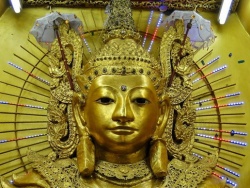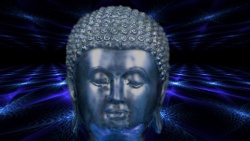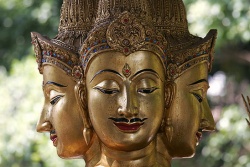The Cult Leader
This is a pre-publication chapter from Take Back Your Life: Recovering from Cults and Abusive Relationships by Janja Lalich and Madeleine Tobias, copyright 2006, published by Bay ree Publishing, Berkeley, Calif.
Chapter 4
The Cult Leader
When people leave a negative or harmful cultic relationship, they often struggle with the question “Why would anyone (my leader, my lover, or my teacher) do this to me?” When the deception and exploitation become evident, the enormous unfairness of the victimization and abuse can be difficult to accept. Often, former cult members have difficulty sorting out their experiences and tend to blame themselves. They don’t immediately comprehend the vital role of the cult leader and at times are reluctant to hold the leader responsible for certain behaviors, actions, and consequences.
A cult cannot be truly explored or understood without understanding its leader. Psychologists Edward Levine and Charles Shaiova write that a cult’s formation, proselytizing methods, and means of influence and control “are determined by certain salient personality characteristics of [the] cult leader.... Such individuals are authoritarian personalities who attempt to compensate for their deep, intense feelings of inferiority, insecurity, and hostility by forming cultic groups primarily to attract those whom they can psychologically coerce into and keep in a passive-submissive state, and secondarily to use them to increase their income [[[Wikipedia:status|status]], or other gain].”1
In examining the motives and activities of cult leaders, it is painfully obvious that cult life is rarely pleasant for devotees, since the power imbalance in cults breeds injustices and abuses of all sorts. As a defense against the heightened anxiety that accompanies such powerlessness, many people in cults and abusive relationships assume a stance of self-blame. Typically, this self-deprecating attitude is reinforced by the group’s self-serving message that the followers are never good enough and are to blame for everything that goes wrong.
Demystifying a guru’s power is an important part of the psychoeducational recovery process. This examination of power is critical to truly gaining freedom and independence from the leader’s control. The process starts with some basic questions: Who was this person who claimed to be God, or all knowing, or all powerful? What did he get out of this masquerade? What was the real purpose of the group (or relationship)?
In cults and abusive relationships, people in subordinate positions usually come to accept responsibility for their abuse, as if they deserve the foul treatment or that it is for their own good. Sometimes, they persist in believing that they are bad rather than considering that the person in whom they believe is untrustworthy, unreliable, or cruel. It is simply too frightening for them to confront the truth: it threatens the balance of power and means risking total rejection, loss, or perhaps even the death of self or loved ones. This explains why an abused or exploited cult member may become disenchanted with the relationship or group, yet continues to believe in the teachings, goodness, and power of the leader. Or at least continues to be under the sway of the leader.
Even after leaving the group or relationship, many former devotees carry a burden of guilt and shame but continue to regard their former leader as paternal, all good, or godlike. This is quite common in those who “walk away” from their groups, especially if they never seek the benefits of exit counseling or therapy. Often, a parallel phenomenon is found in battered women, or in children who are abused by their parents or other adults they admire.
To heal from a traumatic experience of this type, it is important to understand who and what the perpetrator is. So long as there are illusions about the leader’s motivation, powers, and abilities, those who have been in such a grip deprive themselves of an important opportunity for growth: the chance to empower themselves and to become free of the tyranny of dependency on others for their well-being, spiritual growth, or happiness.
The Authoritarian Power Dynamic
The purpose of a cult (whether group, family, or one-on-one) is to serve the emotional, financial, sexual, and/or power needs of the leader. The single most important word here is power. The dynamic around which cults are formed is similar to that of other power relationships and is essentially ultra-authoritarian, based on a disproportional power imbalance. The cult leader, by definition, must have an authoritarian personality in order to fulfill his role in the power dynamic. Traditional elements of authoritarian personalities include the following traits identified by professor of political science Ivan Volgyes: 2
• A tendency toward hierarchy
• A drive for power (and wealth)
• Hostility, hatred, and prejudice
• Superficial judgments of people and events
• A one-sided scale of values favoring the one in power
• The interpretation of kindness as weakness
• A tendency to use people and see others as inferior
• A sadistic-masochistic tendency
• The incapacity to be ultimately satisfied
• Paranoia
In a study of dictators, renowned psychologist Peter Suedfeld writes: “Since compliance depends on whether the leader is perceived as being both powerful and knowing, the ever-watchful and all-powerful leader (and his invisible but observant and powerful instruments, such as secret police) can be invoked in the same way as an unobservable but omniscient God.... Similarly, the pomp and ceremony surrounding such an individual make him more admirable and less like the common herd, increasing both his self-confidence and the confidence of his subjects. The phenomenon is found not only with individual leaders, but with entire movements.”3 Some modern-day dictators have been identified as cult leaders, not only due to the adulation required from the general public in their respective countries, but also due to the controlling and corrupt dynamics of their inner circle of top lieutenants and sycophants. Certainly Adolph Hitler, Joseph Stalin, Mao Zedong, and Pol Pot fit into this cult leader/dictator parallel.
An authoritarian personality, however, is just one aspect of a cult leader. There are other traits and characteristics to consider.
Who Becomes a Cult Leader?
Frequently at gatherings of former cult members, a lively exchange takes place when participants compare their respective groups and leaders. As people begin to describe their special, enlightened, and unique “guru”—whether a pastor, therapist, political leader, teacher, lover, or swami—those present are often surprised to find that their once-revered leaders are really quite similar in temperament and personality. It seems as if these leaders come from a common mold, sometimes light-heartedly called the “Cookie-cutter Messiah School.”
In some cases, the similarities and behavioral patterns noted in cult leaders of all stripes appear to be rooted in troubling personality traits commonly connected with Narcissistic Personality Disorder or Antisocial Personality Disorder (or sociopathy). Psychiatrists, medical doctors, clinical psychologists, and others have studied these traits and diagnostic criteria for more than half a century, and their research provides fascinating insights into this type of authoritarian and abusive personality.
Usually, cult groups originate with a living leader who is believed to be “god” or godlike by a cadre of dedicated believers. Along with a dramatic and convincing talent for self-expression, these leaders have an intuitive ability to sense their followers’ needs and to draw them closer with seductive promises. Gradually, the leader inculcates the group with his own private ideology (and sometimes his bizarre inclinations or predilections). Then, he creates conditions so that his followers cannot or dare not test his claims (how can you prove that someone is not the Messiah? That the world won’t end on such-and-such date? Or that humans are not possessed by aliens from another dimension?). Through social-psychological influence and control, cult leaders manipulate their followers into accepting a new ideology, and then prevent them from testing or disproving it.
It’s clear that mature and psychologically healthy individuals can be induced into dependency on a leader; this is all the more true in a group setting. Jerrold Post, a leader in the field of political-personality profiling, writes:
The skillful charismatic leader intuitively shapes and induces these states in his followers. Some may be attracted to the charismatic religious cults..., others to the path of terrorism..., and especially in times of societal stress, some may be attracted to the banner of the charismatic political leader.... When one is feeling overwhelmed, besieged by fear and doubt, it is extremely attractive to be able to suspend individual judgment and repose one’s faith in the leadership of someone who conveys with conviction and certainty that he has the answers, that he knows the way, be it the Reverend Moon or Reverend Jim Jones, Adolph Hitler or Ayatollah Khomeini. Particularly through skillful use of rhetoric, such a leader persuades his needy audience: “Follow me and I will take care of you. Together we can make a new beginning and create a new society. The fault is not within us but out there, and the only barrier to the happiness, peace, and prosperity we deserve is the outside enemy out to destroy us.”4
The Role of Charisma
In general, charismatic personalities are known for their inescapable magnetism, winning style, and the self-assurance with which they promote something—a cause, a belief, or a product. A charismatic person who offers hope of new beginnings often attracts attention and a following.
Charisma is defined in the Webster’s Collegiate Dictionary (10th ed.) as “an extraordinary power; a personal magic of leadership arousing special popular loyalty or enthusiasm for a public figure (as a political leader); a special magnetic charm or appeal.”5 The German sociologist Max Weber was the first to study charisma in depth in the 1800s. He explained: “the term ‘charisma’ will be applied to a certain quality of an individual personality by virtue of which he is set apart from ordinary men and treated as endowed with supernatural, superhuman, or at least specifically exceptional powers or qualities. His gift is that he succeeds in gathering disciples around him.”6 Weber described a charismatic leader as a “berserker” with spells of maniac passion, a “shaman,” a “magician” who falls into trance through epileptic seizure, a “swindler” of the most sophisticated sort, and even an “intellectual ... carried away with his own demagogic success”; in other words, “men who, according to conventional judgments, are the ‘greatest’ heroes, prophets and saviours.”7 According to Weber, the charismatic person’s claim to legitimacy lies not only in amassing devotees who engage in hero worship, but in engendering a sense of duty among devotees to deify the charismatic one and promise complete fidelity and commitment.
In the case of cults, of course, we know that this induction of whole-hearted devotion does not happen spontaneously, but is the result of systems of influence and control based on an array of thought-reform techniques. Charisma on its own is not evil and does not necessarily breed a cult leader. But essentially, charisma is a powerful and awesome social relationship built on a significant power imbalance. Indeed, the charismatic one has great influence over those who respond to him or her. Often, that response is misinterpreted to be more than it is: a visceral response, an emotional release, an intimate feeling of wonder. The misinterpretation easily results in extreme or irrational reactions on the part of devotees.
An excellent example of this can be seen in the recent phenomenon of the Indian spiritual teacher, Amma, who is known as the “hugging saint.” Literally thousands of people in locations around the world wait for as long as 10 hours to receive a three-second hug from her, and sometimes also a few flower petals or a Hershey’s chocolate kiss shoved into their hands.8 Amma is considered by her devotees to be an avatar, a deity come to Earth, a once-in-a-1,000-year occurrence. Estimates are that she has hugged “somewhere between 25 and 30 million people so far.”9 After the fleeting hug, devotees leave in tears. Whether they are crying from ecstasy or exhaustion, many believe they have had a spiritual experience.
Charisma, of course, is not necessarily nefarious. Famous actors and musicians have charisma, and many high school athletes do too. Charisma is a fascinating phenomenon that often evokes positive responses. Corrupt charismatic cult leaders, however, will use this complex interpersonal phenomenon in ways that are self-serving and, at times, destructive to others. The combination of charisma and certain personality disorders (such as sociopathy) is a lethal mixture—perhaps it is the very recipe used at the Cookie-cutter Messiah School. For a cult leader, charisma is perhaps most useful during the early stages of cult formation. It takes a strong-willed and persuasive leader to convince people of a new belief, and then gather the newly converted around him as devoted followers. A misreading of a cult leader’s so-called personal charisma will foster his adherents’ belief in his divine or messianic qualities.
Charisma is indeed desirable for someone who wishes to attract a following. However, like beauty, charisma is in the eye of the beholder. “Mary,” for example, may be completely taken with a particular workshop leader, practically swooning at his every word, while her friend “Susie” doesn’t feel the slightest tingle. When a person is under the sway of charisma, the effect seems very real. Yet, charisma is nothing more than a worshipful reaction to an idealized figure in the mind of the one who is smitten. When just one person is smitten, a charismatic leader is born. When more than one person feels that same way, a charismatic group may begin to take shape.
In the long run, persuasive skills (which may or may not be charismatic) are more important to the longevity of a cult than is the leader’s charisma. The power and hold of cults is dependent upon the environment or social system shaped by the thought-reform program, the influence and control mechanisms, and the captivating tenets of the belief system—all of which are usually conceptualized and put in place by the leader. The leader’s trusted inner circle or top lieutenants, of course, aid in this process. Some inner circle members achieve “charisma by proxy;” that is, because they are the leader’s confidantes, they carry the authority of the leader.
It’s important to note that the psychopathology of the leader, and not his charisma, is the source of the systematic manipulative exploitation and abuse that may be found in cults. A charismatic leader may have power over people, but he does not necessarily abuse that power, even though the opportunity will always be there.
Personality Disorders in the Cult Leader
Cultic groups and relationships are formed primarily to meet the specific needs of their leaders, many of whom suffer from some form of emotional or character disorder. Few, if any, cult leaders subject themselves to the psychological tests or prolonged clinical interviews that might allow for an accurate diagnosis. However, researchers and clinicians who study and observe cult leaders describe them variously as egocentric, narcissistic, megalomaniacal, neurotic, psychotic, psychopathic, sociopathic, or suffering from a diagnosed personality disorder.10
Clearly, not all cult leaders (nor the leaders of any of the groups mentioned in this book) have personality disorders. Nevertheless, there appears to be significant psychological and social dysfunction in some cult leaders, whose behaviors demonstrate features rather consistent with several disturbing personality disorders. (Note: Among professionals, different terms for these disorders have been “in fashion” at different times. For example, in certain periods, “psychopath” was the preferred nomenclature, while today, “sociopath” or Antisocial Personality Disorder is more commonly used. We hope our use of these different terms won’t be too confusing for the reader. The point to bear in mind is that all three terms essentially refer to the same type of personality disorder.)
Psychiatrist Otto Kernberg sees the antisocial personality as a subgroup of the narcissistic personality: “The main characteristics of these narcissistic personalities are grandiosity, extreme self-centeredness, and a remarkable absence of interest in and empathy for others in spite of the fact that they are so very eager to obtain admiration from other people.”11 Many former cult members report that their leaders appeared to take a “genuine” interest in them in the beginning of their involvement, which they interpreted as loving, insightful, and empathic on the part of the leader. This, however, changed as their involvement deepened and they were challenged to conform to the expectations of the leader and the group.
According to the Diagnostic and Statistical Manual of Mental Disorders (the standard source book used in making psychiatric evaluations and diagnoses), deceit and manipulation are the central features of Antisocial Personality Disorder.12 Prevalence of the disorder is “about 3% in males and about 1% in females.”13 The combination of personality and behavioral traits that allows for this diagnosis must be evident in the person’s history, not simply during a particular episode; that is, it is regarded as a long-term and chronic disorder. Certain inflexible, persistent, and maladaptive behaviors and traits cause a person to have significantly impaired social or occupational functioning. Often, signs of this disorder are first manifested in childhood and adolescence, and are expressed through distorted patterns of perceiving, relating to, and thinking about the environment and oneself.14 In simple terms, this means that something is amiss, awry, or not quite right with the person, which creates problems in how he or she relates to the world.
Robert Hare, an expert in the study of psychopathy, offered a description of the Psychopathic Personality that coincides with the behavior and actions of many cult leaders. Hare estimated that there are at least two million sociopaths, or psychopaths, in North America. He wrote, “Psychopaths are social predators who charm, manipulate, and ruthlessly plow their way through life, leaving a broad trail of broken hearts, shattered expectations, and empty wallets. Completely lacking in conscience and in feelings for others, they selfishly take what they want and do as they please, violating social norms and expectations without the slightest sense of guilt or regret.”15
To be clear, psychopathy is not the same as psychosis. The latter is characterized by an inability to differentiate what is real from what is imagined: boundaries between self and others are lost, and critical thinking is greatly impaired. While generally not psychotic, cult leaders may experience psychotic episodes, which may lead to the destruction of themselves or the group. An extreme example of this is the mass murder-suicide that occurred in November 1978 in Jonestown, Guyana, at the Peoples Temple led by Jim Jones. On his orders, more than 900 men, women, and children perished as Jones deteriorated into what was probably a paranoid psychosis.
Neuropsychiatrist Richard Restak stated, “At the heart of the diagnosis of psychopathy was the recognition that a person could appear normal and yet close observation would reveal the personality to be irrational or even violent.”16 Indeed, initially many persons with personality disorders appear quite normal. They present themselves to us as charming, interesting, even humble. The majority, as authors Ken Magid and Carole McKelvey write “don’t suffer from delusions, hallucinations, or memory impairment, their contact with reality appears solid.”17
Some, on the other hand, may demonstrate marked paranoia and megalomania. In one clinical study of psychopathic inpatients, Darwin Dorr and Peggy Woodhall write: “We found that our psychopaths were similar to normals (in the reference group) with regard to their capacity to experience external events as real and with regard to their sense of bodily reality. They generally had good memory, concentration, attention, and language function. They had a high barrier against external, aversive stimulation.... In some ways they clearly resemble normal people and can thus ‘pass’ as reasonably normal or sane. Yet we found them to be extremely primitive in other ways, even more primitive than frankly schizophrenic patients. In some ways their thinking was sane and reasonable, but in others it was psychotically inefficient and/or convoluted.”18
Researcher Larry Strasburger described people with Antisocial Personality Disorder in this way: “These people are impulsive, unable to tolerate frustration and delay, and have problems with trusting. They take a paranoid position or externalize their emotional experience. They have little ability to form a working alliance and a poor capacity for self-observation. Their anger is frightening. Frequently they take flight. Their relations with others are highly problematic. When close to another person they fear engulfment or fusion or loss of self. At the same time, paradoxically, they desire closeness; frustration of their entitled wishes to be nourished, cared for, and assisted often leads to rage. They are capable of a child’s primitive fury enacted with an adult’s physical capabilities, and action is always in the offing.”19 Ultimately, “the psychopath must have what he wants, no matter what the cost to those in his way.”20
The Master Manipulator
How might some of this be manifested in a cult leader? Cult leaders have an outstanding ability to charm and win over followers. They beguile and seduce. They enter a room and garner all the attention. They command unwavering allegiance and strict obedience. These are, as Richard Restak wrote “individuals whose narcissism is so extreme and grandiose that they exist in a kind of splendid isolation in which the creation of the grandiose self takes precedence over legal, moral or interpersonal commitments.”21
Paranoia may be evident in simple or elaborate delusions of persecution. Highly suspicious, they may feel conspired against, spied on, cheated, or maligned by a person, group, or governmental agency. Any real or suspected unfavorable reaction may be interpreted as a deliberate attack on them or the group (considering the criminal nature of some groups and the antisocial behavior of others, such fears may have a basis in reality).
Harder to evaluate, of course, is whether these leaders’ belief in their magical powers, omnipotence, and connection to God (or whatever higher power or belief system they are espousing) is delusional or simply part of the con. Megalomania, or the belief that one is able or entitled to rule the world, is equally hard to evaluate without psychological testing, although numerous cult leaders state quite readily that their goal is to rule the world. In any case, beneath the surface gloss of intelligence, charm, and professed humility seethes an inner world of rage, depression, and fear.
“Trust Bandit” 22 is one way to describe these characters: indeed, it is an apt description of these thieves of our hearts, souls, minds, bodies, and pocketbooks. Given that a significant percentage of current and former cult members have been in more than one cultic group or relationship, learning to recognize the personality style of the Trust Bandit can be a useful antidote to further abuse.
The Profile of a Sociopath
The 15 characteristics outlined below, based on the checklists developed by Cleckley and Hare, identify features commonly found in those who perpetrate psychological and physical abuse.23 For purposes of this discussion, “sociopath” and “cult leader” are used interchangeably. A case study of Branch Davidian leader David Koresh follows this section in order to illustrate these points. In reading the profile, bear in mind these common characteristics that Lifton finds in cult situations:
• A charismatic leader who ... increasingly becomes the object of worship
• A series of processes that can be associated with “coercive persuasion” or “thought reform”
• The tendency toward manipulation from above ... with exploitation—economic, sexual, or other—of often-genuine seekers who bring idealism from below24
We are not suggesting that all cult leaders are sociopaths, but rather that some exhibit many sociopathic behavioral characteristics. Neither are we proposing that you use this checklist to make a diagnosis. Instead, we offer this checklist as a tool to help you label and demystify traits you may have noticed in your leader.
1. Glibness and Superficial Charm
Glibness is a hallmark of sociopaths. They are able to use language effortlessly to beguile, confuse, and convince. They are captivating storytellers. They exude self-confidence and are able to spin a web that intrigues others and pulls them into the sociopath’s life. Most of all, they are persuasive. Frequently, they have the capacity to destroy their detractors verbally or disarm them emotionally.
2. Manipulative and Conning
Sociopaths do not recognize the individuality or rights of others, which makes any and all self-serving behaviors permissible. This type of person is adept at the “psychopathic maneuver,” identified by psychiatrist Ethel Person as interpersonal manipulation “based on charm. The manipulator appears to be helpful, charming, even ingratiating or seductive, but is covertly hostile, domineering.... [The victim] is perceived as an aggressor, competitor, or merely as an instrument to be used....”25 In other words, there are no checks on a sociopath’s behavior—anything goes.
The sociopath divides the world into suckers, sinners, and himself. He discharges powerful feelings of terror and rage by dominating and humiliating his victims. He is particularly successful when, through an overlay of charm, he makes an ally of his victim—a process sometimes described as emotional vampirism or emotional terrorism. Examples of this type of manipulation are plentiful in the literature on Jonestown, Charles Manson’s Family, and other cult groups. It is especially prevalent in one-on-one cultic relationships and family cults.
3. Grandiose Sense of Self
The sociopathic cult leader enjoys tremendous feelings of entitlement. He believes everything is owed to him as a right. Preoccupied with his own fantasies, he must always be the center of attention. He presents himself as the Ultimate One: enlightened, a vehicle of god, a genius, the leader of humankind, and sometimes even the most humble of humble. He has an insatiable need for adulation and attendance. His grandiosity may also be a defense against inner emptiness, depression, and feelings of insignificance. Paranoia often accompanies the grandiosity, reinforcing the sequestering of the group and the need for protection against a perceived hostile environment. In this way, he creates an us-versus-them mentality.
4. Pathological Lying
Sociopaths lie coolly and easily, even when it is obvious they are being untruthful. It is almost impossible for them to be consistently truthful about either a major or minor issue. They lie for no apparent reason, even when it would seem easier and safer to tell the truth. This is sometimes called “crazy lying.”26 Confronting these lies may provoke an unpredictably intense rage or simply a Buddha-like smile.
Another form of lying common among cult leaders is known as pseudologica fantastica, which is an extension of pathological lying. Leaders tend to create a complex belief system, often about their own powers and abilities, in which they themselves sometimes get caught up. Psychiatrist Scott Snyder wrote that “It is often difficult to determine whether the lies are an actual delusional distortion of reality or are expressed with the conscious or unconscious intent to deceive.”27
These manipulators are rarely original thinkers. Plagiarists and thieves, they seldom credit the true originators of their ideas. They are extremely convincing, forceful in the expression of their views, and talented at passing lie detector tests. For them, objective truth does not exist. The only “truth” is whatever will help them achieve their needs. This type of opportunism is very difficult to understand for those who are not sociopaths. For this reason, followers are more apt to invent or go along with all kinds of explanations and rationales for apparent inconsistencies in behavior: “I know my guru must have had a good reason for doing this” or “He did it because he loves me—even though it hurts.”
5. Lack of Remorse, Shame, and Guilt
At the core of the sociopath is a deep-seated rage, which is split off (i.e., psychologically separated from the rest of the self) and repressed. Some researchers theorize that this is caused by feeling abandoned in infancy or early childhood.28 Whatever the emotional or psychological source, sociopaths see those around them as objects, targets, or opportunities, not as people. They do not have friends, they have victims and accomplices—and the latter frequently end as victims. For sociopaths, the ends always justify the means and there is no place for feelings of remorse, shame, or guilt. Sociopathic cult leaders feel justified in all their actions since they consider themselves the ultimate moral arbiter. Nothing gets in their way.
6. Shallow Emotions
While sociopaths may display outbursts of emotion, these are more often than not responses calculated to obtain a certain result. They rarely reveal a range of emotions, and those they do reveal are superficial at best, and fabricated at worst. Positive feelings of warmth, joy, love, and compassion are more feigned than experienced. They are unmoved by things that would upset the normal person, but outraged by insignificant matters. They are bystanders to the emotional lives of others, perhaps envious and scornful of feelings they cannot have or understand. In the end, psychopaths are cold, with shallow emotions, and they live in a dark world of their own.
Hiding behind the “mask of sanity,” the sociopathic cult leader exposes feelings only insofar as they serve an ulterior motive. He can witness or order acts of utter brutality without experiencing a shred of emotion. He casts himself in a role of total control, which he plays to the hilt. What is most promised in cults—peace, joy, enlightenment, love, and security—are goals that are forever out of reach of the leader, and thus also the followers. Since the leader is not genuine, neither are his promises.
7. Incapacity for Love
Although he may refer to himself, for example, as the “living embodiment of God’s love,” the leader is tragically flawed because he is unable to give or receive love. Love substitutes are given instead. A typical example might be the guru’s claim that his illness or misfortune (otherwise inconsistent with his enlightened state) is caused by the depth of his compassion for his followers, whereby he takes on their negative karma. Not only are devotees supposed to accept this as proof of his love, but also they are expected to feel guilt for their failings. It becomes impossible for members to disprove this claim once they have accepted the beliefs of the group.
The leader’s tremendous need to be loved is accompanied by an equally strong disbelief in the love offered by his followers, which results in often unspeakably cruel and harsh “testing” of his devotees. Unconditional surrender is an absolute requirement. In one cult, for example, the mother of two small children was made to tell them nightly that she loved her leader more than them. Later, as a test of her devotion, she was asked to give up custody of her children in order to be allowed to stay with her leader. The guru’s love is never tested; it must be accepted at face value.
8. Need for Stimulation
Thrill-seeking behaviors, often skirting the letter or spirit of the law, are common among sociopaths. Such behavior is sometimes justified as preparation for martyrdom: “I know I don’t have long to live; therefore my time on this earth must be lived to the fullest” or “Surely even I am entitled to have fun or sin a little.” Commonly, this type of behavior becomes more frequent as the sociopath deteriorates emotionally and psychologically.
Cult leaders live on the edge, constantly testing the beliefs of their followers, often with increasingly bizarre behaviors, punishments, and lies. Stimulation can also be had through unexpected, seemingly spontaneous outbursts, which typically take the form of verbal abuse and sometimes physical punishment. The sociopath has a cool indifference to things around him, yet his icy coldness can quickly turn into rages vented on those around him.
9. Callousness and Lack of Empathy
Sociopaths readily take advantage of others, expressing utter contempt for the feelings of others. Someone in distress is not important to them. Although intelligent, perceptive, and quite good at sizing people up, they make no real connections with others. They use their “people skills” to exploit, abuse, and wield power.
Sociopathic cult leaders are unable to empathize with the pain of their victims. Cult victims engage in denial about this callousness, because it’s so difficult to believe that someone they love so much could intentionally hurt them. It therefore becomes easier to rationalize the leader’s behavior as necessary for the general or individual “good.” The alternative for the devotee would be to face the sudden and overwhelming awareness of being victimized, deceived, and used. Such a realization would wound the person’s deepest sense of self, so as a means of self-protection, the person denies the abuse. When and if the devotee becomes aware of the exploitation, sometimes it feels as though a tremendous evil has been done.
10. Poor Behavioral Controls and Impulsive Nature
Like small children, many sociopaths have difficulty regulating their emotions. Adults who have temper tantrums are frightening to be around. Rage and abuse, alternating with token expressions of love and approval, produce an addictive cycle for both abuser and abused (and a sense of hopelessness in the latter). This dynamic has also been recognized in relation to domestic abuse and the battering of women.29
The sociopathic cult leader acts out with some regularity—often privately, sometimes publicly—usually to the embarrassment and dismay of his followers and other observers. He may act out sexually, aggressively, or criminally, frequently with rage. Who could possibly control someone with no sense of personal boundaries or responsibility, who believes himself to be all powerful, all knowing, and entitled to every wish or whim? Generally, such aberrant behavior is a well-kept secret, known only to a few trusted disciples. The others see only perfection.
These tendencies are related to the sociopath’s need for stimulation and his inability to tolerate frustration, anxiety, or depression. Often, a leader’s inconsistent behavior needs to be rationalized by either the leader or the followers in order to maintain internal consistency. This inconsistency is often regarded as divinely inspired and further separates the empowered from the powerless.
11. Early Behavior Problems and Juvenile Delinquency
Sociopaths frequently have a history of behavioral and academic difficulties. They often “get by” academically, taking advantage of other students and teachers. Encounters with juvenile authorities are frequent. Equally prevalent are difficulties in peer relationships, developing and keeping friends, self-control, and managing aberrant behaviors such as stealing, arson, and cruelty to others.
12. Irresponsibility and Unreliability
Not concerned about the consequences of their behavior, sociopaths leave behind them the wreckage of other peoples’ lives and dreams. They may be totally oblivious or indifferent to the devastation they inflict on others, which they regard as neither their problem nor their responsibility.
Sociopathic cult leaders rarely accept blame for their failures or mistakes. Scapegoating is common, and blame falls upon followers, those outside the group, a member’s family, the government, Satan—anyone and everyone but themselves. The blaming may follow a ritualized procedure such as a trial, “hot seat” denunciation, or public confession (either privately or in front of the group). Blame is a powerful reinforcer of passivity and obedience that produces guilt, shame, terror, and conformity in followers.
13. Promiscuous Sexual Behavior and Infidelity
Promiscuity, child sexual abuse, multiple relationships and marriages, rape, and sexual acting out of all sorts are behaviors frequently practiced by sociopathic cult leaders. Conversely, there may be stringent sexual control of followers through such tactics as enforced celibacy, arranged marriages, forced breakups and divorces, removal of children from their parents, forced abortions, and mandated births. For sociopaths, sex is primarily a control and power issue.
Along with this behavior comes vast irresponsibility, not only for the followers’ emotions but also for their lives. In one cult, for example, multiple sexual relations were encouraged even though one of the top leaders was known to be HIV positive. This kind of negligence toward others is not uncommon among sociopaths.
Marital fidelity is rare among sociopaths. There are usually reports of countless extramarital affairs and sexual predation of adult and child members of both sexes. The sexual behavior of such a leader may be kept hidden from all but the inner circle or may be part of accepted group sexual practices. In any case, due to the power imbalance between leader and followers, sexual contact is never truly consensual and is likely to have damaging consequences for the follower.
14. Lack of Realistic Life Plan and Parasitic Lifestyle
The sociopathic cult leader tends to move around a lot, making countless efforts at “starting over” while seeking out fertile new ground to exploit. One day, he may appear as a rock musician, the next, a messiah; one day a door-to-door salesman, the next, founder of a self-rejuvenation program; one day a college professor, the next, the new “Lenin” bringing revolution to America.
The flip side of this erratic lifestyle is the all-encompassing promise for the future that the cult leader makes to his followers. Many groups claim as their goal world domination or salvation at the time of the Apocalypse. The leader is the first to proclaim the utopian nature of the group, which generally is a justification for irrational behavior and stringent controls.
Often, the leader’s sense of entitlement is demonstrated by the contrast between his luxurious lifestyle and the impoverishment of his followers. Most cult leaders are supported by gifts and donations from their devotees, who may be pressured to turn over much of their income and worldly possessions to the group. Sympathetic outsiders and “fellow travelers” are also prime targets for solicitations for financial contributions to support the leader. Slavery, enforced prostitution, and a variety of illegal acts for the benefit of the leader are common in a cult milieu. This type of exploitation aptly demonstrates Lifton’s third point, which is idealization from below and exploitation from above.
Sociopaths also tend to be preoccupied with their own health while remaining totally indifferent to the suffering of others. They may complain of being “burned out” due to the burden of “caring for” their followers, sometimes stating they do not have long to live, which instills fear and guilt in their devotees and encourages further servitude. They are highly sensitive to their own pain and tend to be hypochondriacs, which often conflicts with their public declarations of superhuman self-control and healing abilities. According to them, the illnesses they don’t get are due to their powers, while the ones they do get are caused by their “compassion” in taking on their disciples’ karma or solving the group’s problems.
15. Criminal or Entrepreneurial Versatility
Cult leaders change their image and that of the group as needed to avoid prosecution and litigation, to increase income, and to recruit a range of members. Cult leaders have an innate ability to attract followers who have the skills and connections that the leaders lack. The longevity of the group is dependent on the willingness of the leadership to adapt as needed to preserve the group. Frequently, when illegal or immoral activities are exposed to the public, the cult leader will relocate, sometimes taking all or some of his followers with him. He will keep a low profile, only to resurface later with a new name, a new front group, and perhaps a new twist on his story.
A Case Example: David Koresh
In Waco, Texas, on April 19, 1993, more than 80 men, women, and children died as fire swept through the Branch Davidian compound known as Ranch Apocalypse. These Davidians were an unaffiliated offshoot of the Seventh-Day Adventist Church. The members were followers of David Koresh, who called himself the “Sinful Messiah.” Koresh’s devotees believed until the very end that their lives were his to give or take away. Some still hold this belief.
Immediately after the dreadful televised conflagration, controversy erupted over the origination of the fire: was it set off by the armored vehicles the FBI used to inject tear gas into the building to force evacuation, or was the fire deliberately set inside the building by loyal followers at Koresh’s order? Could it have been both? On some level, the answer will never be known. Nevertheless, some of us who watched in horror as flames engulfed the buildings knew one thing for sure: this was no mass suicide. Rather, it was the unfortunate and gruesome ending for a group of people under the sway of a sociopathic charismatic cult leader.
In the period of analysis following the tragedy, some mental health professionals classified Koresh as psychotic while others called him a psychopath or sociopath. Richard Restak, in an article in the Washington Post, bitterly attacked the government’s mishandling of the affair. He believed that the tragedy could have been averted if Koresh had been treated as a psychotic and not “just another criminal.” Restak described the chief indicators of psychosis: “a delusional preoccupation with persecution, usually associated with grandiosity; more or less continuous erratic, disorganized excitement accompanied by irascibility; bizarre delusional ideas coupled with obvious indifference to social expectations; and pervasive convictions of evil or wickedness in self or others.” According to Restak, “Koresh satisfied these criteria in spades.”30
Another article questioned whether Koresh suffered from “Jerusalem syndrome.” 31 Eli Witztum, a psychiatrist who treats and studies that disorder, explained that some pilgrims to Jerusalem become delusional and disoriented while visiting the city, requiring hospitalization before being stabilized and sent home. Pilgrims of all faiths and nationalities have experienced these religious and paranoid delusions. Koresh visited Jerusalem in 1985. Though there is no record of Koresh’s admission to a psychiatric hospital, Witztum speculated that Koresh’s visit to the Holy City intensified his messianic self-image.
Koresh exhibited many of the psychotic traits outlined by Restak and others, but we feel that primarily he was not psychotic, but was a sociopath. In the following analysis of his personality profile, we highlight the characteristics of sociopaths in italic type to facilitate reading. It is important to note that even though the focus here is on the sociopathic characteristics of Koresh’s personality, we must not forget his capacity for charm and his skills of persuasion that helped bring dozens into the realm of his influence. Koresh was intensely serious, dedicated, and convincing, and his followers believed him to be a man of God.
David Koresh (born Vernon Wayne Howell) was the illegitimate child of a 15-year-old mother.32 When he was two, his father left home and his mother eventually married another man. According to his grandmother, David and his stepfather did not get along; Koresh said he was abused at home. Early behavior problems were apparent. A poor student with a history of learning disabilities and poor attendance, Koresh dropped out of school in the ninth grade. In 1979, at about age 19, he was expelled from the Seventh-Day Adventist Church as a troublemaker, and a bad influence on the young people of the church. He wanted power and would not adhere to church principles. From an early age, he had a striking ability to memorize passages of the Bible. With glibness and superficial charm, he exploited this skill as a teacher of the Scriptures and leader of his future flock.
In the early 1980s Koresh joined a Branch Davidian sect led by the Roden family. Through manipulation and a variety of power plays, Koresh was able to wrest control of the group by conning and outwitting the leader, George Roden. In 1987 Roden challenged Koresh to see who had more divine power (the challenge was to bring a deceased group member back to life). When Roden exhumed the body, Koresh had him arrested for “corpse abuse.” An armed conflict followed between Koresh and Roden. Although Koresh was arrested and charged with attempted murder, his trial ended in a hung jury and the charges were dropped.
While Roden was incarcerated, Koresh took over the group and began using classic thought-reform techniques, such as isolation, sleep deprivation, physical exhaustion through mindless activity and overwork, food deprivation, and phobia induction. He led long hours of indoctrination, sometimes subjecting his followers to 15-hour sessions of Bible study. Koresh built up a following of several hundred men, women, and children, including those recruited on his trips to Israel, Australia, England, and other parts of the United States.
His grandiose sense of self was well known. His business card was imprinted “Messiah,” and he stated on countless occasions, “If the Bible is true, then I’m Christ.” Some believed him. He was able to convince husbands to give up their wives to him, and families to turn over their money and children. By April 19, 1993, there were almost one hundred people who believed in his promise of a heavenly afterlife.
Koresh’s callousness and lack of empathy were apparent in the treatment of his followers, especially the children, whom he abused physically, emotionally, and sexually, then held as hostages during the FBI standoff, pawns in his ultimate power play. In the end, there were probably 25 children among the followers who died. Koresh’s pathological lying was directed at media, government forces, and his followers. For example, he repeatedly reneged on promises to surrender, and he assured his followers that they would be safe in underground bunkers. His lack of remorse, shame, or guilt was evident over the years as he frequently admitted that he was a sinner without equal. At no time is he known to have shown remorse for the harm inflicted on so many of his followers or for the suffering of their families.
Koresh clearly revealed his incapacity for love and sexual instability by bedding and “wedding” all the women in the group, including other men’s wives and girls as young as 12 years old. After demanding celibacy from all the men, Koresh must have wallowed in sadistic enjoyment as he was openly sexual with their wives, even though some of these men were his most loyal lieutenants. He displayed a restless need for stimulation in his stockpiling of weapons and ammunition, his irrational outbursts, and his frenzied activity within the compound. Poor behavior controls were evident in his raging at and physical abuse of the children and adults who worshiped him, and in his constantly changing rules about acceptable behavior. His parasitic lifestyle allowed him to live off the earnings of others while he regarded himself as a biblical king, Christ himself. His impulsive nature was apparent in the punishments that rained down on adults and children alike at any perceived disrespect or disobedience. He ruled by whim and fiat; he ruled by terror.
His criminal versatility was exhibited throughout his life. A known troublemaker since his teens, he had been arrested for attempted murder, had stockpiled illegal weapons, and had sexually abused children and others. Finally, his own death and that of his followers—whether the fires were accidentally ignited by FBI tanks or deliberately set by cult members—showed his total irresponsibility, to say the least. To a person with this type of antisocial personality disorder, those who follow him are fools, suckers, and dupes. They don’t exist as people, they are playthings to be used and abused. The idea of taking responsibility is as foreign to such a person as the ability to feel compassion, empathy, or sympathy, unless he has some ulterior motive in simulating such feelings.
Throughout his life, David Koresh displayed a sense of purpose. He also had the ruthless determination to reach his objectives, no matter what the cost to others. It is likely that his behavior suffered a psychotic degeneration under the intense pressure of his last two months under siege by the ATF and FBI. Mental health professionals and cult researchers may continue for some time to question the diagnoses attributed Koresh, not so much as a matter of scientific debate as an issue of deep social concern.
Unmasking the Guru
As you read the 15-point checklist and David Koresh’s profile, you may notice characteristics that match and explain some of the attributes, attitudes, and behaviors of your leader. Unmasking or demystifying the leader is an important part of postcult recovery. Becoming familiar with the characteristics of this personality disorder may help you prevent being revictimized. Here are some questions to ask about your own experience:
• How well did you know your leader? Was it through firsthand knowledge or others’ accounts?
• What did you feel when you met him or her?
• Did those feelings change during the time you spent in the group or relationship?
• Was your leader charismatic, charming, quick-witted, or able to sway a crowd? How were those qualities used by your leader to get his or her way?
• Did you believe your leader to have special powers, exalted spirituality, or special knowledge? Do you still believe that?
• Did you ever catch your leader lying or faking? Being inconsistent? How did you rationalize what you saw and heard when it was clearly aberrant, irrational, or abusive?
• How did your leader rationalize his or her behavior when it was aberrant, irrational, or abusive?
• How many of the 15 traits listed in the profile did you observe in your leader?
• Were there second-level leaders in your group? Did they psychologically resemble the leader or were they devoted disciples blindly following orders?
• What do you know of your leader’s childhood, adolescence, and early adulthood? Does he or she fit the pattern?
• Were you sexually intimate with your leader? How did that relationship come about and how was it explained or justified?



















